
A package of supplies for administering vaccines sent from McKesson to University of Pittsburgh Medical Center is shown on Dec. 10.
Photo: Tim Betler/University of Pittsburgh Medical Center
Federal officials are taking a page from the playbook used during the H1N1 pandemic in plans to speed vials of Moderna Inc.’s Covid-19 vaccine to thousands of locations if the shot is cleared for use by U.S. regulators.
The U.S. rollout plan for the Moderna vaccine and any others authorized after that relies on McKesson Corp. , one of the world’s largest drug wholesalers, as a go-between to manage the shipment of shots as well as syringes and other supplies needed for inoculations.
The strategy contrasts with Pfizer Inc.’s distribution effort for the vaccine it developed with partner BioNTech SE. To cut down on time in transit, Pfizer is shipping that vaccine, which must be kept at ultralow temperatures, directly to hospitals and public health organizations, which are preparing the doses for use with supply kits McKesson is shipping separately.
A Food and Drug Administration advisory panel recommended Thursday that Moderna’s Covid-19 vaccine be cleared for broad use, setting the stage for the agency to grant an expected emergency-use authorization Friday.

McKesson is one of the world’s largest drug wholesalers and the biggest vaccine middleman in the U.S.
Photo: Jeff Chiu/Associated Press
The distribution plan developed by the federal Operation Warp Speed program is to have the Moderna vaccine shipped from manufacturing sites to McKesson distribution centers for staging with the supply kits. FedEx Corp. and United Parcel Service Inc. are to deliver the vaccines to sites designated by 64 U.S. states, territories and other jurisdictions.
Irving, Texas-based McKesson is the nation’s largest middleman for seasonal-flu shots and distributed the H1N1 vaccine during that pandemic in 2009 and 2010.
The Covid-19 vaccine effort is several orders of magnitude larger, however, involving hundreds of millions of doses that must be shipped under strict temperature requirements in one of the largest mass mobilizations in decades. The Centers for Disease Control and Prevention is managing centralized distribution through an existing contract option with McKesson.
“We’ve been working to scale up the infrastructure necessary to be ready to distribute approved vaccines as soon as they are available,” McKesson Chief Executive Brian Tyler said in a Nov. 3 earnings call.
“ “The framework is largely the same as what was used for the H1N1 distribution.” ”
“Based on the volumes that we’ve been given and projections, we have quickly been engaged in standing up some new facilities, both for the vaccine distribution and for the kitting and frankly for just some storage,” Mr. Tyler said. “It’s a big effort…but something that we’ve successfully done in the past.”
Those facilities include two new cold-chain sites outside Memphis, Tenn., and Louisville, Ky. Future sites will be brought online to meet anticipated demand, a McKesson spokeswoman said.
“The framework is largely the same as what was used for the H1N1 distribution,” said Julie Swann, a professor and head of the industrial and systems engineering department at North Carolina State University in Raleigh, N.C., who advised the CDC during the H1N1 pandemic.
The government sets the vaccine allocations around the U.S. Each state or jurisdiction decides where those doses will go, the order is sent to McKesson, “and it gets shipped out the door,” said Dr. Swann.
As with H1N1, initial delivery of the shots to inoculation sites, local distribution hubs and big retail pharmacy networks involved in the vaccination program will be handled by commercial shipping companies, mostly the major parcel carriers. “They do this every day, and have systems for shipping vaccines,” she said.
The Moderna vaccine doesn’t require the ultracold temperatures needed to keep the Pfizer vaccine stable.
Unlike the Pfizer and BioNTech shot, Moderna’s can be maintained at minus 4 degrees Fahrenheit, or minus 20 degrees Celsius, which most home or medical freezers can achieve. Most pharmaceutical distribution companies also can ship and store products at that temperature, Moderna says.
Plans call for the prospective Moderna vaccine to be shipped to 3,285 sites—more than five times as many as those receiving the Pfizer shot—because the government has had more time to plan its rollout, Gen. Gustave Perna, chief operating officer of Operation Warp Speed, the federal government’s coronavirus vaccine program, said in a briefing Monday.
Moderna expects to produce 20 million finished doses in the U.S. this month. The doses will ship from manufacturing sites to a “fill-finish” facility where the vaccine is put into vials and packaged for distribution. Somerset, N.J.-based pharmaceutical-services contractor Catalent Inc. has said it is working with Moderna to perform fill-finish work at its facility in Bloomington, Ind.
From there, the Moderna shots are to be handed off to McKesson. The distributor’s RxCrossroads unit will move the vaccine by truck to its third-party logistics facility, then move the shots to dedicated Covid-19 vaccine distribution centers, the McKesson spokeswoman said. McKesson will oversee delivery to hospitals and other sites, primarily via FedEx and UPS.
Relying on one company to manage distribution for an effort of this scale and complexity carries some risk. “It will be an extraordinary challenge for one company to oversee vaccinations of more than 300 million people through one distribution network,” retired U.S. Navy Admiral James Stavridis wrote in a Fortune magazine commentary last month.
The Covid-19 vaccination push is about three to four times bigger than the annual U.S. flu vaccine distribution effort, and covers a similar time period of around six months, Moncef Slaoui, Operation Warp Speed’s chief scientific adviser, said Wednesday.
Although development and manufacturing of the vaccines have been faster than anticipated, Dr. Slaoui said, the fundamentals for distributing and administering the Covid-19 shots aren’t significantly different than for flu vaccines, so “using the existing capabilities and resources is the appropriate and right thing to do.”
Write to Jennifer Smith at [email protected]
Copyright ©2020 Dow Jones & Company, Inc. All Rights Reserved. 87990cbe856818d5eddac44c7b1cdeb8








